Prospectivity Mapping for Magmatic-Related Seafloor Massive Sulfide on the Mid-Atlantic Ridge Applying Weights-of-Evidence Method Based on GIS
Abstract
:1. Introduction
2. Study Area
3. Genesis of Seafloor Massive Sulfide Deposits on the Mid-Atlantic Ridge
4. Data Compilation, Mapping, and Mineral Potential Model
4.1. Data Compilation and Mapping
4.1.1. Hydrothermal Fields
4.1.2. Terrain Information
Water Depth
Slope Gradient
4.1.3. Geological Information
Oceanic Crust Thickness
Ridge Axis
Faults
Bedrock Age
Spreading Rate
4.1.4. Geophysical Information
Bouguer Gravity
Magnetism
Seismic Point Density
4.2. Mineral Potential Model of Seafloor Massive Sulfide Deposits
5. Mineral Prospectivity Mapping
6. Discussion
6.1. Important Prospecting Criteria
6.2. Prospecting Targets
7. Conclusions
Author Contributions
Funding
Institutional Review Board Statement
Informed Consent Statement
Data Availability Statement
Acknowledgments
Conflicts of Interest
References
- Tao, C.; Li, H.; Jin, X.; Zhou, J.; Wu, T.; He, Y.; Deng, X.; Gu, C.; Zhang, G.; Liu, W. Seafloor hydrothermal activity and polymetallic sulfide exploration on the southwest Indian ridge. Chin. Sci. Bull. 2014, 59, 2266–2276. [Google Scholar] [CrossRef]
- Hannington, M.; Jamieson, J.; Monecke, T.; Petersen, S. Estimating the Metal Content of SMS Deposits 2011; IEEE: Piscataway, NJ, USA, 2011; pp. 1–4. [Google Scholar]
- Corliss, J.B.; Dymond, J.; Gordon, L.I.; Edmond, J.M.; von Herzen, R.P.; Ballard, R.D.; Green, K.; Williams, D.; Bainbridge, A.; Crane, K. Submarine thermal springs on the Galapagos Rift. Science 1979, 203, 1073–1083. [Google Scholar] [CrossRef] [PubMed]
- Beaulieu, S.E.; Baker, E.T.; German, C.R. Where are the undiscovered hydrothermal vents on oceanic spreading ridges? Deep Sea Res. Part II Top. Stud. Oceanogr. 2015, 121, 202–212. [Google Scholar] [CrossRef] [Green Version]
- Dai, Y.; Liu, S.J.; Liu-Jun, L.I.; Xiao-Zhou, H.U. Sampling techniques and equipments for sms exploration by nautilus minerals inc. Mar. Geol. Quat. Geol. 2008, 29, 863–870. [Google Scholar]
- Jie, F.; Jingwen, S.; Hongqing, X.; Jinhua, Y.; Jianping, C.; Mengyi, R.; Chao, T. Mineral prospectivity mapping of seafloor massive sulfide on the Northern Mid-Atlantic Ridge. Adv. Earth Sci. 2015, 30, 60–68. (In Chinese) [Google Scholar]
- Ke, S. Quantitative Prediction and Evaluation of Seafloor Massive Sulfide in the North Atlantic Ocean; China University of Geosciences: Beijing, China, 2016. (In Chinese) [Google Scholar]
- Kleinrock, M.C.; Humphris, S.E. Structural asymmetry of the TAG Rift Valley: Evidence from a near-bottom survey for episodic spreading. Geophys. Res. Lett. 2013, 23, 3439–3442. [Google Scholar] [CrossRef]
- Devey, C.W.; German, C.R.; Haase, K.M.; Lackschewitz, K.S.; Melchert, B.; Connelly, D.P. The Relationships between Volcanism, Tectonism, and Hydrothermal Activity on the Southern Equatorial Mid-Atlantic Ridge. In Diversity of Hydrothermal Systems on Slow Spreading Ocean Ridge; American Geophysical Union: Washington, DC, USA, 2013. [Google Scholar]
- Fouquet, Y. Where are the large hydrothermal sulphide deposits in the oceans? Philos. Trans. R. Soc. Lond. Ser. A 1997, 355, 427–441. [Google Scholar] [CrossRef]
- Humphris, S.E.; Kleinrock, M.C. Detailed morphology of the TAG Active Hydrothermal Mound: Insights into its formation and growth. Geophys. Res. Lett. 2013, 23, 3443–3446. [Google Scholar] [CrossRef]
- Demartin, B.J.; Sohn, R.A.; Canales, J.P.; Humphris, S.E. Kinematics and geometry of active detachment faulting beneath the Trans-Atlantic Geotraverse (TAG) hydrothermal field on the Mid-Atlantic Ridge. Geology 2007, 35, 711–714. [Google Scholar] [CrossRef] [Green Version]
- Fouquet, Y.; Cambon, P.; Etoubleau, J.; Charlou, J.L.; OndréAs, H.; Barriga, F.J.; Cherkashov, G.; Semkova, T.; Poroshina, I.; Bohn, M. Geodiversity of Hydrothermal Processes along the Mid-Atlantic Ridge and Ultramafic-Hosted Mineralization: A New Type of Oceanic Cu-Zn-Co-Au Volcanogenic Massive Sulfide Deposit; Wiley-Blackwell: Hoboken, NJ, USA, 2013; pp. 321–367. [Google Scholar]
- Canales, J.P.; Sohn, R.A.; Demartin, B.J. Crustal structure of the Trans-Atlantic Geotraverse (TAG) segment (Mid-Atlantic Ridge, 26°10′ N): Implications for the nature of hydrothermal circulation and detachment faulting at slow spreading ridges. Geochem. Geophys. Geosyst. 2007, 8. [Google Scholar] [CrossRef]
- Garcés, M.; Gee, J.S. Paleomagnetic evidence of large footwall rotations associated with low-angle faults at the Mid-Atlantic Ridge. Geology 2007, 35, 279–282. [Google Scholar] [CrossRef]
- Lowell, R.P.; Rona, P.A. Seafloor hydrothermal systems driven by the serpentinization of peridotite. Geophys. Res. Lett. 2002, 29, 21–26. [Google Scholar] [CrossRef] [Green Version]
- McCaig, A.M.; Delacour, A.; Fallick, A.E.; Castelain, T.; Früh-Green, G.L. Detachment fault control on hydrothermal circulation systems: Interpreting the subsurface beneath the TAG hydrothermal field using the isotopic and geological evolution of oceanic core complexes in the Atlantic. Divers. Hydrothermal. Syst. Slow Spreading Ocean. Ridges Geophys. Monogr. Ser. 2010, 188, 207–240. [Google Scholar]
- Bonham-Carter, G.F. Geographic Information Systems for Geoscientists: Modelling with GIS; Elsevier: Amsterdam, The Netherlands, 1994. [Google Scholar]
- Tivey, M.A.; Dyment, J. The magnetic signature of hydrothermal systems in slow spreading environments. Divers. Hydrothermal. Syst. Slow Spreading Ocean. Ridges Geophys. Monogr. Ser. 2010, 188, 43–65. [Google Scholar]
- Cann, J.R.; Strens, M.R. Modeling periodic megaplume emission by black smoker systems. J. Geophys. Res. Solid Earth 1989, 94, 12227–12237. [Google Scholar] [CrossRef]
- Lim, E.; Eakins, B.; Taylor, L.A. Challenges Integrating Bathymetric and Topographic Datasets of American Samoa. AGUFM 2009, 2009, U21E-2188. [Google Scholar]
- Bougault, H.; Charlou, J.L.; Fouquet, Y.; Needham, H.D.; Vaslet, N.; Appriou, P.; Baptiste, P.J.; Rona, P.A.; Dmitriev, L.; Silantiev, S. Fast and slow spreading ridges—Structure and hydrothermal activity, ultramafic topographic highs, and CH4 output. J. Geophys. Res. Solid Earth 1993, 98, 9643. [Google Scholar] [CrossRef]
- Gràcia, E.; Escartín, J. Crustal accretion at mid-ocean ridges and backarc spreading centers: Insights from the Mid-Atlantic Ridge, the Bransfield Basin and the North Fiji Basin. Contrib. Sci. 2000, 1, 175–192. [Google Scholar]
- Liu, L.; Lowell, R.P. Models of hydrothermal heat output from a convecting, crystallizing, replenished magma chamber beneath an oceanic spreading center. J. Geophys. Res. Solid Earth 2009, 114, B02102. [Google Scholar] [CrossRef] [Green Version]
- Baker, E.T.; Chen, Y.J.; Morgan, J.P. The relationship between near-axis hydrothermal cooling and the spreading rate of mid-ocean ridges. Earth Planet. Sci. Lett. 1996, 142, 137–145. [Google Scholar] [CrossRef]
- Cannat, M.; Briais, A.; Deplus, C.; Escart, N.J.; Georgen, J.; Lin, J.; Mercouriev, S.; Meyzen, C.; Muller, M.; Pouliquen, G. Mid-Atlantic Ridge–Azores hotspot interactions: Along-axis migration of a hotspot-derived event of enhanced magmatism 10 to 4 Ma ago. Earth Planet. Sci. Lett. 1999, 173, 257–269. [Google Scholar] [CrossRef]
- White, R.S.; Minshull, T.A.; Bickle, M.J.; Robinson, C.J. Melt generation at very slow-spreading oceanic ridges: Constraints from geochemical and geophysical data. J. Pet. 2001, 42, 1171–1196. [Google Scholar] [CrossRef] [Green Version]
- Matthews, K.J.; Müller, R.D.; Wessel, P.; Whittaker, J.M. The tectonic fabric of the ocean basins. J. Geophys. Res. Atmos. 2011, 116, B12109. [Google Scholar] [CrossRef] [Green Version]
- Peucker Ehrenbrink, B.; Miller, M.W. Quantitative bedrock geology of east and Southeast Asia (Brunei, Cambodia, eastern and southeastern China, East Timor, Indonesia, Japan, Laos, Malaysia, Myanmar, North Korea, Papua New Guinea, Philippines, far-eastern Russia, Singapore, Korea, Taiwan, Thailand, Vietnam). Geochem. Geophys. Geosyst. 2004, 5, Q01B06. [Google Scholar]
- Müller, R.D.; Sdrolias, M.; Gaina, C.; Roest, W.R. Age, spreading rates, and spreading asymmetry of the world’s ocean crust. Geochem. Geophys. Geosyst. 2008, 9, Q04006. [Google Scholar] [CrossRef]
- Rona, P.A.; Scott, S.D. A special issue on sea-floor hydrothermal mineralization; new perspectives; preface. Econ. Geol. 1993, 88, 1935–1976. [Google Scholar] [CrossRef]
- Humphris, S.E.; Tivey, M.K. A synthesis of geological and geochemical investigations of the TAG hydrothermal field: Insights into fluid-flow and mixing processes in a hydrothermal system. Spec. Pap. Geol. Soc. Am. 2000, 349, 213–235. [Google Scholar]
- Hannington, M.D.; Jamieson, J.; Monecke, T.; Petersen, S. Modern Sea-Floor Massive Sulfides and Base Metal Resources: Toward an Estimate of Global Sea-Floor Massive Sulfide Potential; Society of Economic Geologists: Littleton, CO, USA, 2010. [Google Scholar]
- Reid, I.D.; Jackson, H.R. Oceanic spreading rate and crustal thickness. Mar. Geophys. Res. 1981, 5, 165–172. [Google Scholar]
- Chen, Y.J. Oceanic crustal thickness versus spreading rate. Geophys. Res. Lett. 2013, 19, 753–756. [Google Scholar] [CrossRef]
- Tucholke, B.E.; Lin, J.; Kleinrock, M.C.; Tivey, M.A.; Reed, T.B.; Goff, J.; Jaroslow, G.E. Segmentation and crustal structure of the western Mid-Atlantic Ridge flank, 25°25′–27°10′ N and 0–29 m.y. J. Geophys. Res. Solid Earth 1997, 102, 10203–10223. [Google Scholar] [CrossRef] [Green Version]
- Sauter, D.; Sloan, H.; Cannat, M.; Goff, J.; Patriat, P.; Schaming, M.; Roest, W.R. From slow to ultra-slow: How does spreading rate affect seafloor roughness and crustal thickness? Geology 2011, 39, 911–914. [Google Scholar] [CrossRef]
- Bonvalot, S.; Balmino, G.; Briais, A.; Kuhn, M.; Peyrefitte, A.; Vales, N.; Biancale, R.; Gabalda, G.; Reinquin, F. World Gravity Map: A Set of Global Complete Spherical Bouguer and Isostatic Anomaly Maps and Grids. In Proceedings of the EGU General Assembly 2012, Vienna, Austria, 22–27 April 2012; p. 11091. [Google Scholar]
- Kowalczyk, P. Geophysical Exploration for Submarine Massive Sulfide Deposits; IEEE: Piscataway, NJ, USA, 2011; pp. 1–5. [Google Scholar]
- Maus, S.; Barckhausen, U.; Berkenbosch, H.; Bournas, N.; Brozena, J.; Childers, V.; Dostaler, F.; Fairhead, J.D.; Finn, C.; Von Frese, R. EMAG2: A 2–arc min resolution Earth Magnetic Anomaly Grid compiled from satellite, airborne, and marine magnetic measurements. Geochem. Geophys. Geosyst. 2009, 10. [Google Scholar] [CrossRef]
- Huang, P.Y.; Solomon, S.C. Centroid depths of mid-ocean ridge earthquakes: Dependence on spreading rate. J. Geophys. Res. Solid Earth 1988, 93, 13445–13477. [Google Scholar] [CrossRef]
- Glasby, G.P. The relation between earthquakes, faulting, and submarine hydrothermal mineralization. Mar. Georesour. Geotechnol. 1998, 16, 145–175. [Google Scholar] [CrossRef]
- Bonham-Carter, G.F. Application of a Microcomputer-Based Geographic Information System to Mineral-Potential Mapping. In Microcomputer Applications in Geology; Pergamon Press: Oxford, UK, 1990; pp. 49–74. [Google Scholar]
- Harris, D.P.; Harris, H. Mineral. Resources Appraisal: Mineral Endowment, Resources, and Potential Supply: Concepts, Methods and Cases; Oxford University Press: New York, NY, USA, 1984. [Google Scholar]
- Rona, P.A.; Devey, C.W.; Dyment, J.; Murton, B.J. Diversity of Hydrothermal Systems on Slow Spreading Ocean Ridges. EOS Trans. Am. Geophys. Union 2013, 92, 68–69. [Google Scholar]
- Williams, D.L.; Von Herzen, R.P. Heat Loss from the Earth: New Estimate. Geology 1974, 2, 327. [Google Scholar] [CrossRef]
- Rona, P.A.; Bostrom, K.; Laubier, L.; Smith, K.L. Hydrothermal processes at seafloor spreading centers. Earth Sci. Rev. 1984, 20, 1–104. [Google Scholar] [CrossRef]
- Jenkins, W.J.; Edmond, J.M.; Corliss, J.B. Excess 3He and 4He in Galapagos submarine hydrothermal waters. Nature 1978, 272, 156–158. [Google Scholar] [CrossRef]
- Lin, J.; Morgan, J.P. The spreading rate dependence of three-dimensional mid-ocean ridge gravity structure. Geophys. Res. Lett. 1992, 19, 13–16. [Google Scholar] [CrossRef] [Green Version]
- Williams, C.M.; Stephen, R.A.; Smith, D.K. Hydroacoustic events located at the intersection of the Atlantis (30° N) and Kane (23°40’ N) Transform Faults with the Mid-Atlantic Ridge. Geochem. Geophys. Geosyst. 2013, 7, Q06015. [Google Scholar] [CrossRef]
- Novikov, G.V.; Shulga, N.A.; Lobus, N.; Bogdanova, O.Y. Adsorption of Heavy Metal Cations by Polymetallic Sulphides of the Hydrothermal Fields of Broken Spur and the TAG Atlantic Ocean. Lithol. Miner. Resour. 2020, 55, 55–62. [Google Scholar] [CrossRef]
- Shulga, N.A.; Peresypkin, V.I. New Data on the Composition of Organic Matter in the Hydrothermal Deposits of the Mid-Atlantic Ridge (Broken Spur, Snake Pit, TAG). Dokl. Earth Sci. 2012, 444, 773–775. [Google Scholar] [CrossRef]
- Fouquet, Y.; Wafik, A.; Cambon, P.; Mevel, C.; Meyer, G.; Gente, P. Tectonic setting and mineralogical and geochemical zonation in the Snake Pit sulfide deposit (Mid-Atlantic Ridge at 23° N). Econ. Geol. 2018, 88, 2018–2036. [Google Scholar] [CrossRef]
- Shilov, V.V.; Bel’Tenev, V.E.; Ivanov, V.N.; Cherkashev, G.A.; Kuznetsov, V.Y. New hydrothermal ore fields in the Mid-Atlantic Ridge: Zenith-Victoria (20°08′ N) and Petersburg (19°52′ N). Dokl. Earth Sci. 2012, 442, 63–69. [Google Scholar] [CrossRef]
- Simonov, V.A.; Peyve, A.A.; Kolobov, V.Y.; Milosnov, A.A.; Kovyazin, S.V. Magmatic and hydrothermal processes in the Bouvet Triple Junction Region (South Atlantic). Terra Nova 2010, 8, 415–424. [Google Scholar] [CrossRef]

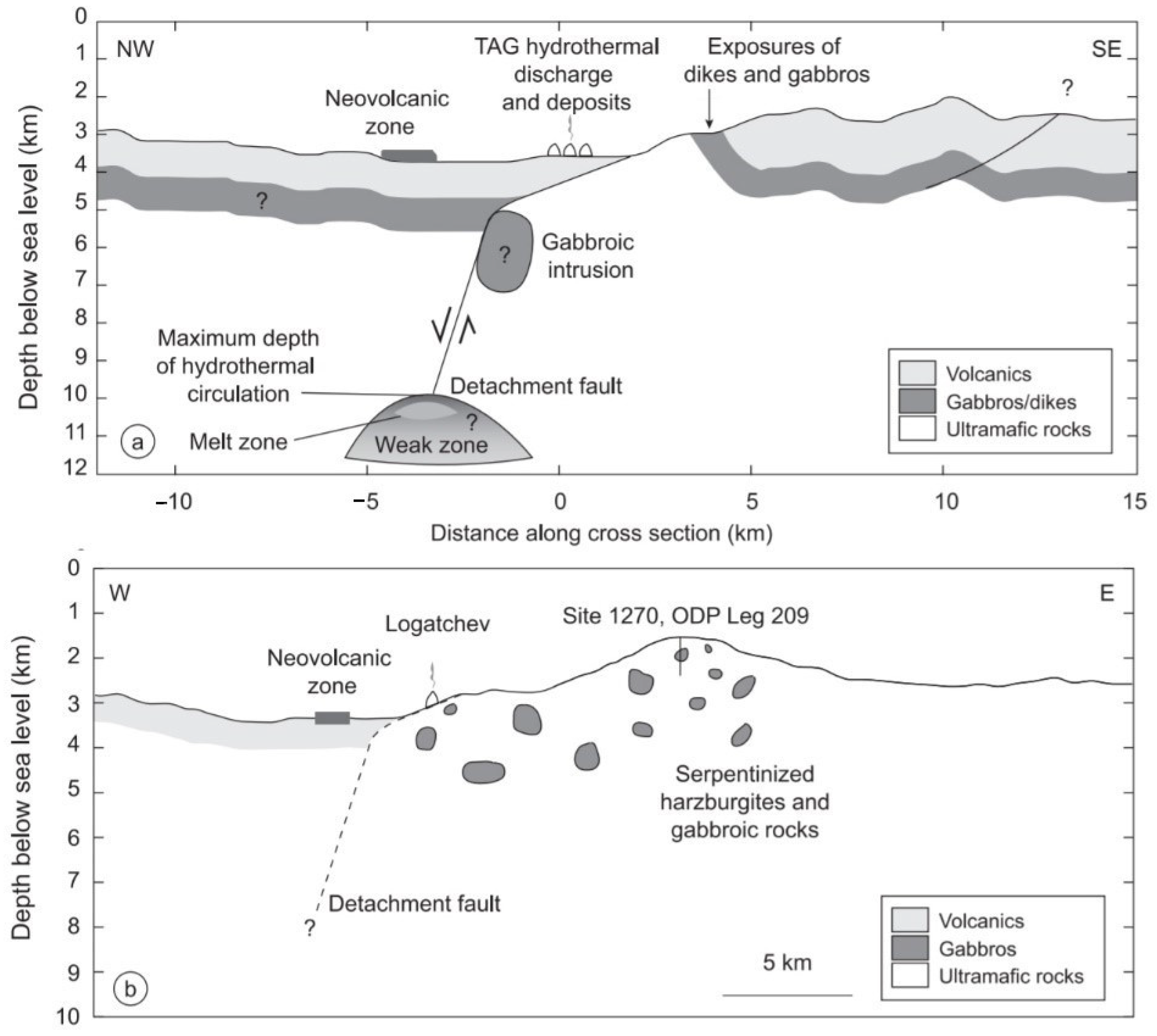

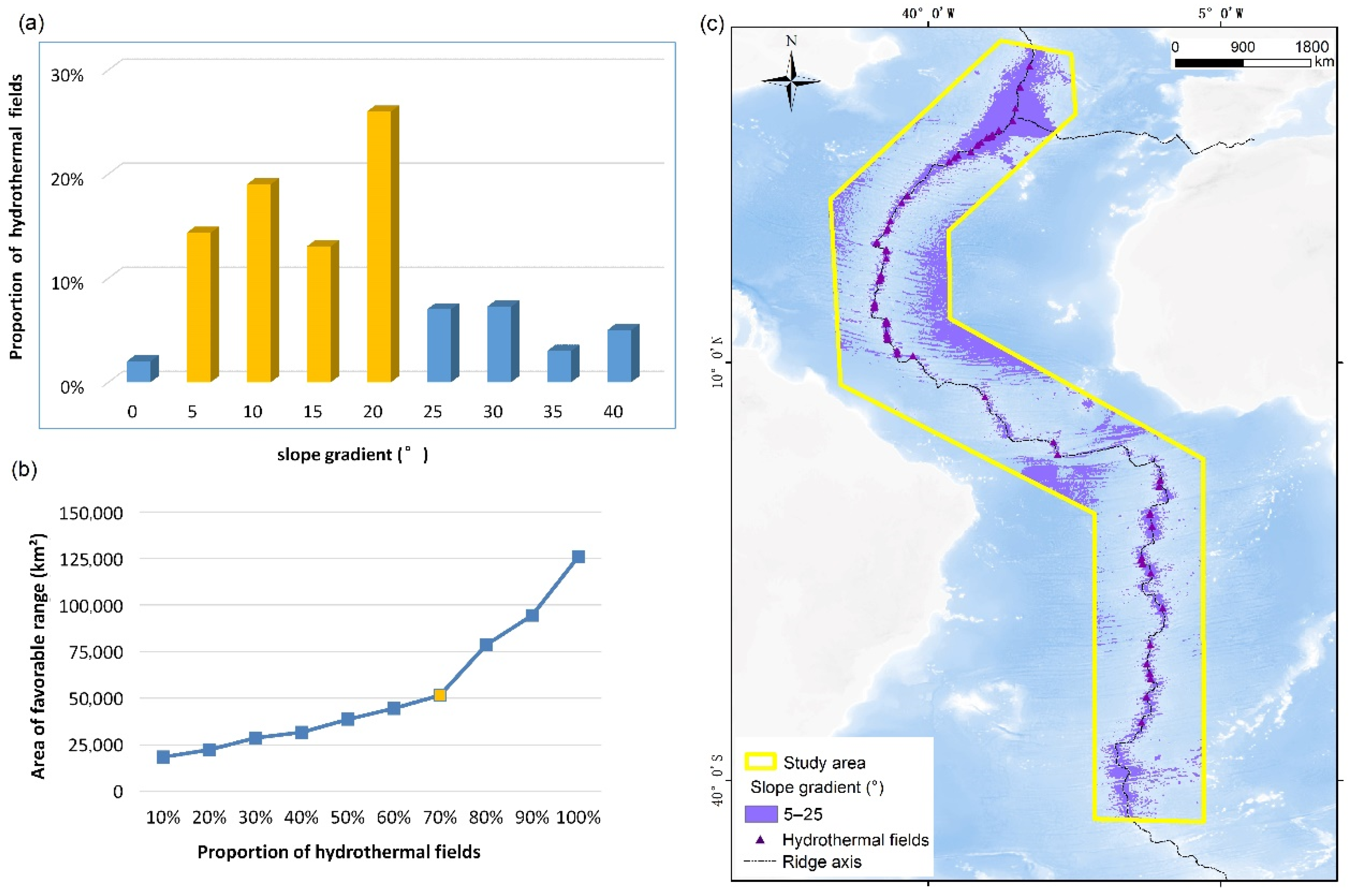


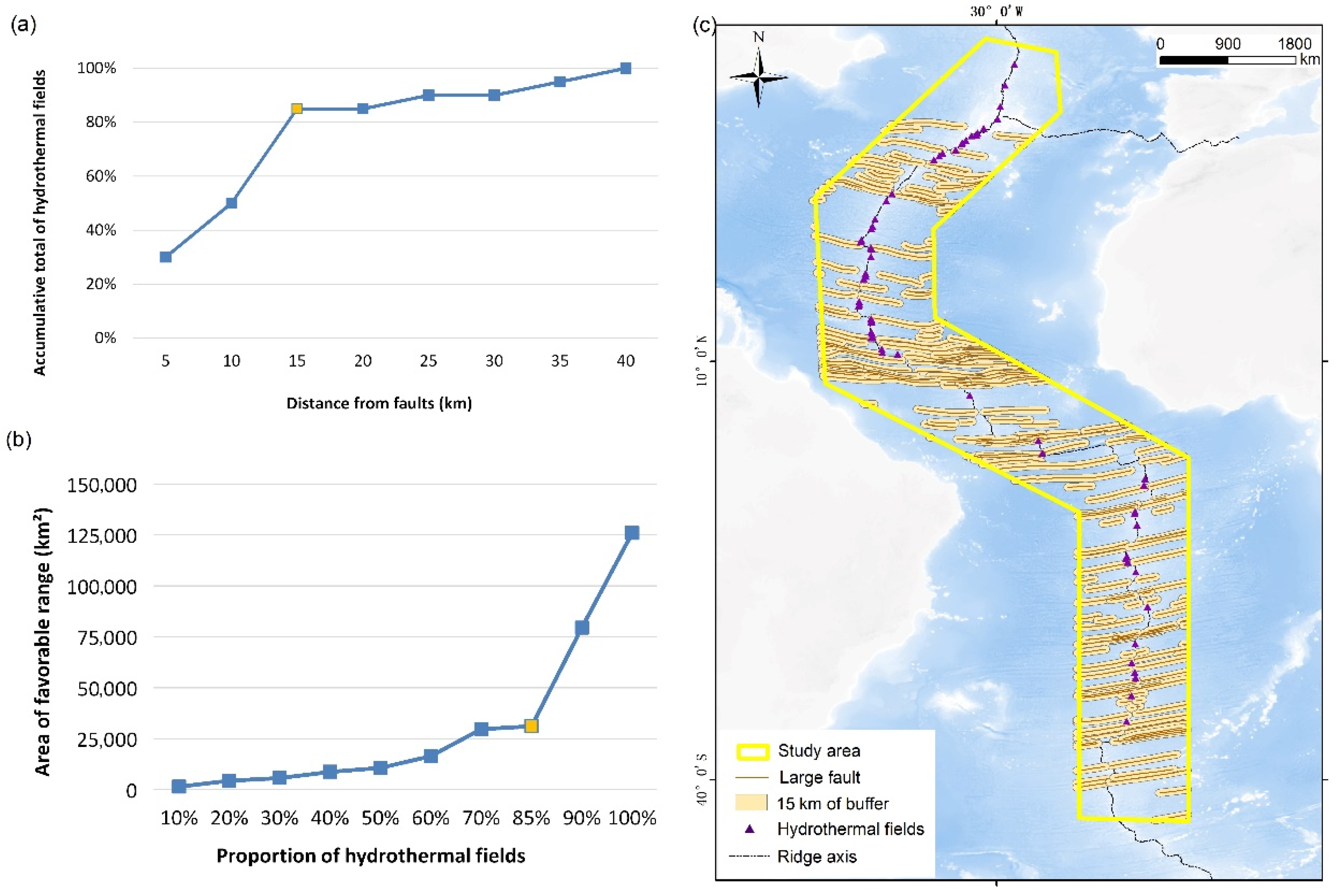


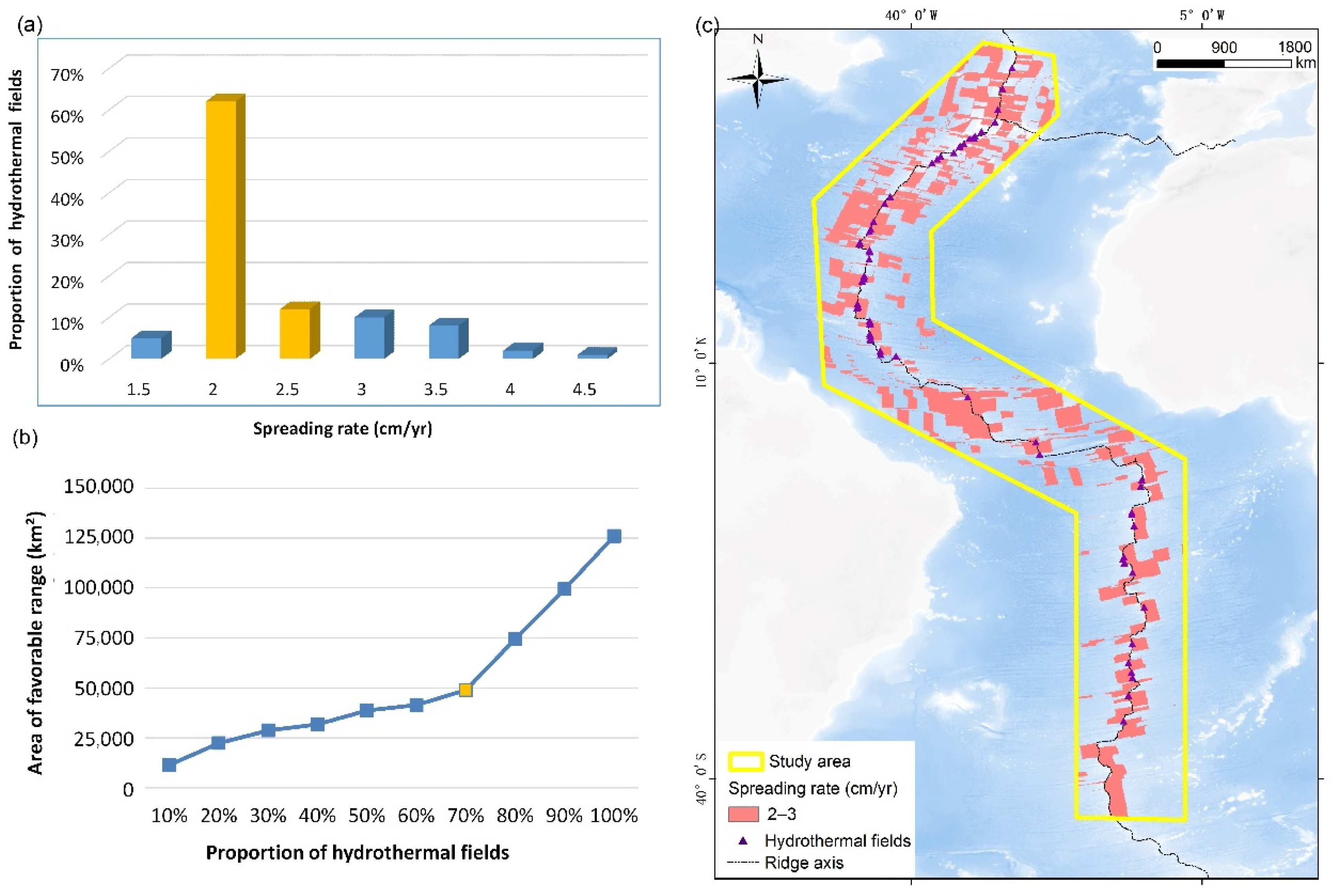


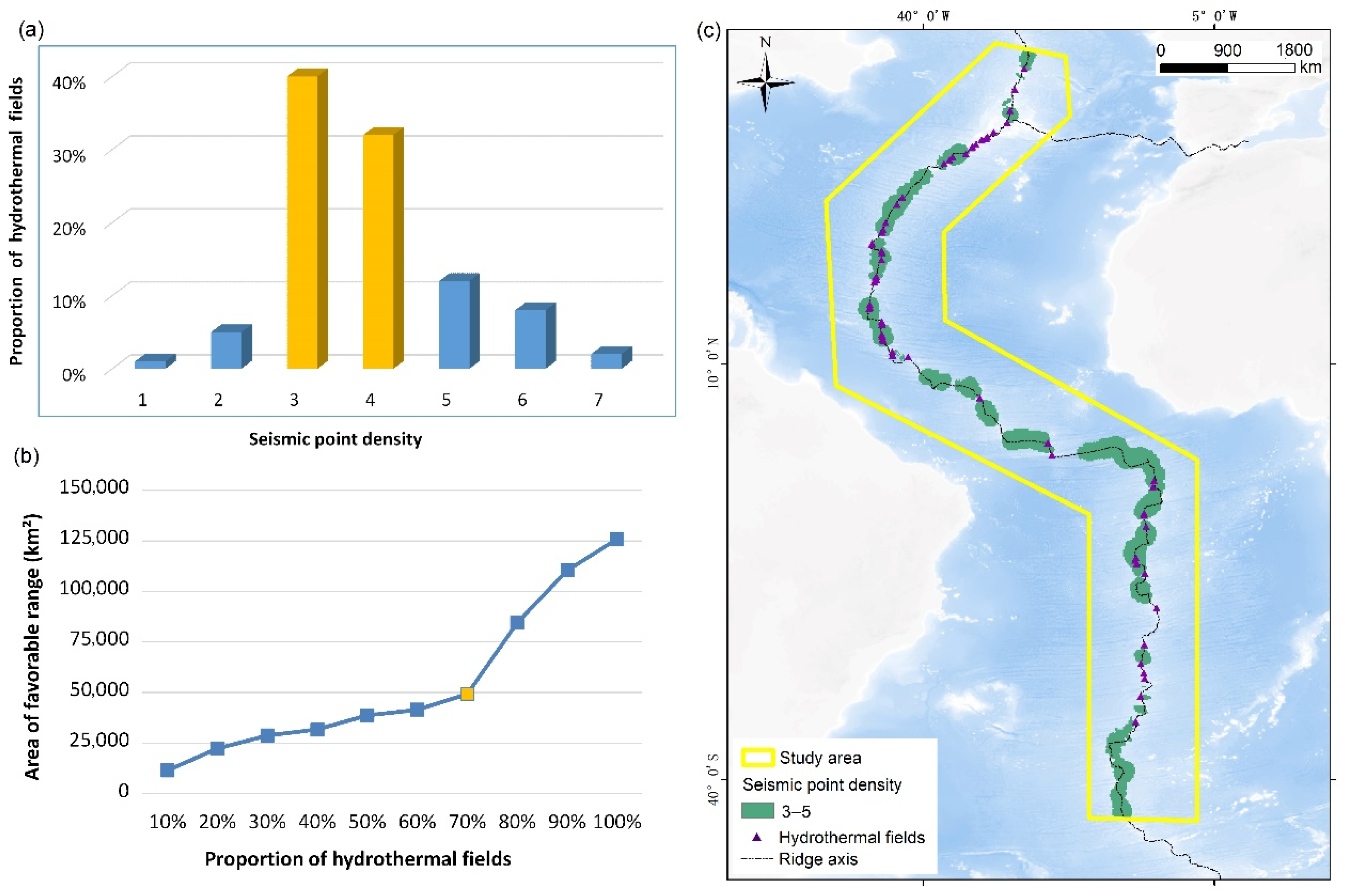
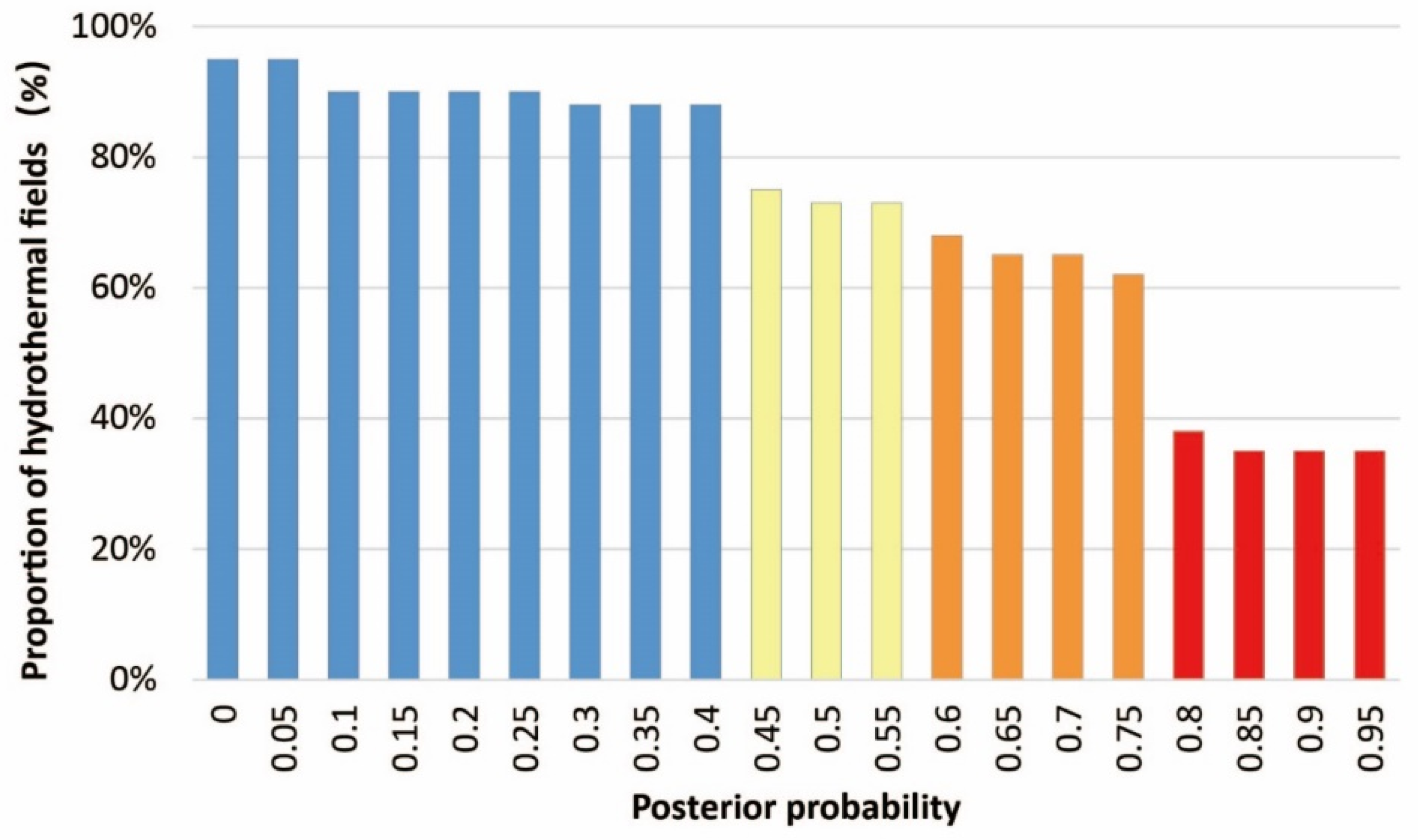
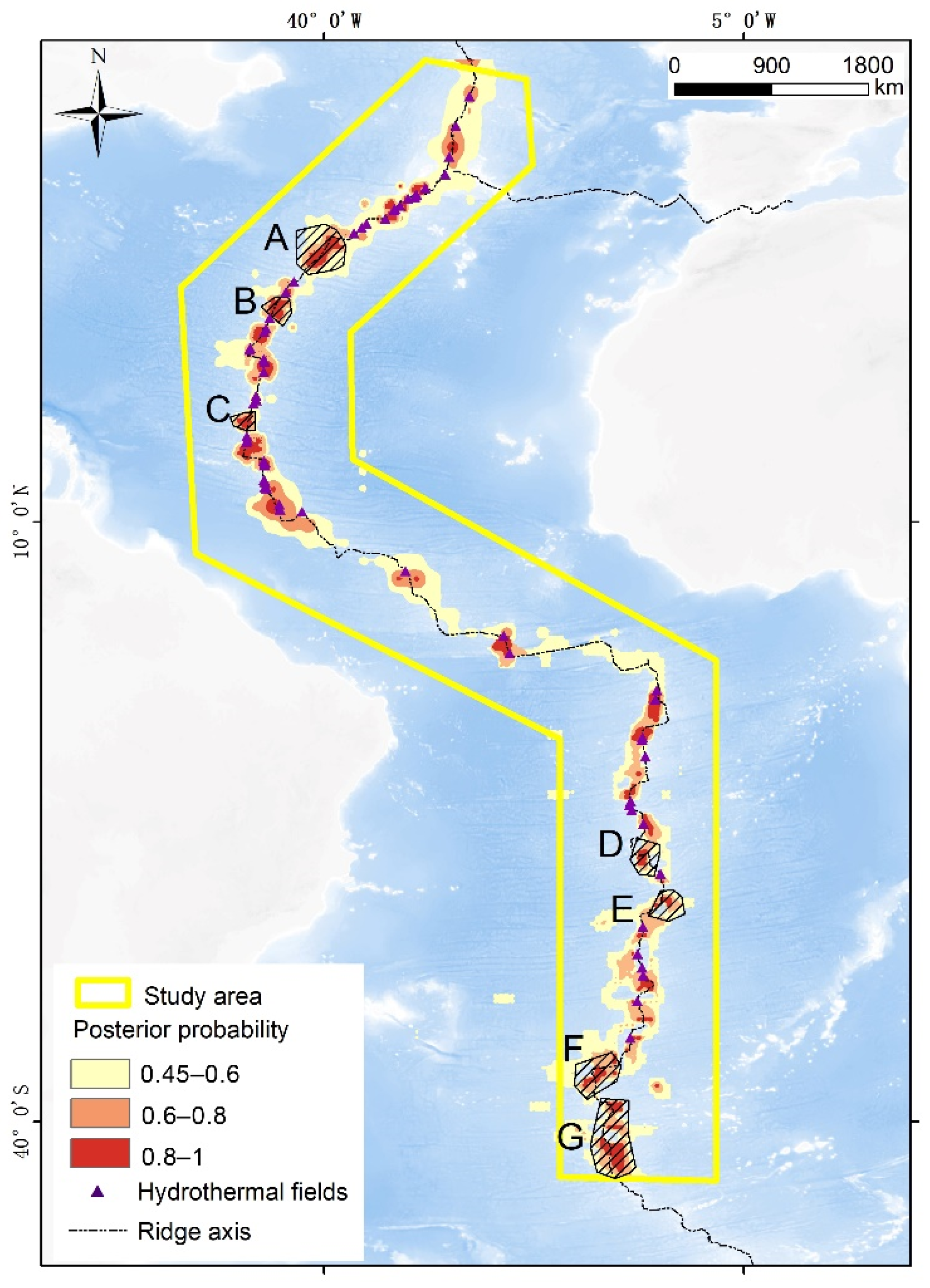
| ID | Name | Longitude | Latitude | Activity |
|---|---|---|---|---|
| 1 | AMAR | −33.65 | 36.38 | active, inferred |
| 2 | Ashadze 4 | −44.85 | 12.97 | inactive |
| 3 | Broken Spur | −43.17 | 29.17 | active, confirmed |
| 4 | Bubbylon | −31.53 | 37.80 | active, confirmed |
| 5 | Deyin-1 | −13.36 | −15.17 | active, confirmed |
| 6 | Evan | −32.28 | 37.27 | active, confirmed |
| 7 | Krasnov | −46.48 | 16.64 | inactive |
| 8 | Lilliput | −13.18 | −9.55 | active, confirmed |
| 9 | Logatchev 3 | −44.97 | 14.71 | active, inferred |
| 10 | Logatchev 4 | −44.91 | 14.71 | inactive |
| 11 | Lucky Strike | −32.27 | 37.29 | active, confirmed |
| 12 | Sth. Lucky Strike, NTO3 | −32.42 | 37.05 | active, inferred |
| 13 | Luso | −29.88 | 38.98 | active, confirmed |
| 14 | MAR, 11 26′ N | −43.70 | 11.45 | active, inferred |
| 15 | MAR, 11 N | −43.65 | 11.04 | active, inferred |
| 16 | MAR, 12 48′ N | −44.79 | 12.80 | inactive |
| 17 | MAR, 13 19′N OCC | −44.90 | 13.33 | active, inferred |
| 18 | MAR, 14 54′ N | −44.90 | 14.92 | active, inferred |
| 19 | MAR, 16 46′ N | −46.38 | 16.80 | inactive |
| 20 | MAR, 17 09′ N | −46.42 | 17.15 | active, inferred |
| 21 | MAR, 19 S | −11.94 | −19.33 | active, inferred |
| 22 | MAR, 22 30′ N | −45.01 | 22.50 | inactive |
| 23 | MAR, 23 35′ N | −45.00 | 23.58 | inactive |
| 24 | MAR, 23 S | −13.39 | −23.74 | active, inferred |
| 25 | MAR, 24 20 ′N | −46.20 | 24.35 | inactive |
| 26 | MAR, 24 30′ N | −46.15 | 24.50 | inactive |
| 27 | MAR, 25 50′ N | −44.98 | 25.81 | inactive |
| 28 | MAR, 27 N | −44.50 | 27.00 | active, inferred |
| 29 | MAR, 27 S | −13.48 | −27.15 | active, inferred |
| 30 | MAR, 28 S | −13.37 | −27.79 | active, inferred |
| 31 | MAR, 30 N | −42.50 | 30.03 | active, inferred |
| 32 | MAR, 30 S | −13.85 | −29.95 | active, inferred |
| 33 | MAR, 33 S | −14.44 | −33.02 | active, inferred |
| 34 | MAR, 4 02′ S | −12.25 | −4.03 | active, inferred |
| 35 | MAR, 4 48′ S | −12.37 | −4.81 | active, confirmed |
| 36 | MAR, 43 N | −29.00 | 43.00 | active, inferred |
| 37 | MAR, 7 57′ S | −13.44 | −7.95 | active, inferred |
| 38 | MAR, 8 10′ S | −13.47 | −8.17 | active, inferred |
| 39 | MAR, segment south of St. Paul system | −25.00 | 0.50 | active, inferred |
| 40 | MAR, south of 15 20′ N fracture zone | −45.00 | 15.08 | active, inferred |
| 41 | Markov Deep | −33.18 | 5.91 | active, inferred |
| 42 | Menez Gwen | −31.53 | 37.84 | active, confirmed |
| 43 | Menez Hom | −32.43 | 37.15 | active, confirmed |
| 44 | Merian | −13.85 | −26.02 | active, inferred |
| 45 | Moytirra | −27.85 | 45.48 | active, confirmed |
| 46 | N Oceanographer | −34.87 | 35.28 | active, inferred |
| 47 | Neptune′s Beard | −44.90 | 12.91 | active, inferred |
| 48 | North FAMOUS | −32.97 | 36.97 | active, inferred |
| 49 | Puy des Folles | −45.64 | 20.51 | active, inferred |
| 50 | Rainbow Bay | −14.34 | −14.03 | active, inferred |
| 51 | Romanche Fracture Zone | −24.51 | −0.98 | inactive |
| 52 | S AMAR 1 | −34.08 | 36.08 | active, inferred |
| 53 | S AMAR 2 | −34.18 | 35.97 | active, inferred |
| 54 | S Oceanographer | −36.43 | 34.87 | active, inferred |
| 55 | S-OH1 | −36.85 | 34.53 | active, inferred |
| 56 | S-OH2 | −37.48 | 34.07 | active, inferred |
| 57 | Semyenov | −44.96 | 13.51 | active, confirmed |
| 58 | Snake Pit | −44.95 | 23.37 | active, confirmed |
| 59 | South Kurchatov | −29.55 | 40.47 | active, inferred |
| 60 | St. Petersburg | −45.87 | 19.87 | active, inferred |
| 61 | TAG | −44.83 | 26.14 | active, confirmed |
| 62 | TaiJi | −14.52 | −13.59 | active, inferred |
| 63 | Vema Fracture Zone | −41.80 | 10.85 | inactive |
| 64 | Zenith-Victory | −45.62 | 20.13 | inactive |
| 65 | Zouyu ridge | −14.41 | −13.28 | active, confirmed |
| Ore-Controlling Factors | Characteristic Variables | Favorable Range |
|---|---|---|
| Terrain Information | Water depth | [−3000, −2500] m |
| Slope gradient | [5, 25]° | |
| Geology Information | Oceanic crust thickness | [7600–8500] m |
| Large faults | 15 km buffer | |
| Small faults | 25 km buffer | |
| Ridge axis | 10 km buffer | |
| Bedrock age | [0, 5] Ma | |
| Spreading rate | [2, 2.5] cm/yr | |
| Geophysical Information | Bouguer gravity | [10, 30] mGal |
| Magnetism | [−10, 30] nt | |
| Seismic point density | [3, 5] |
| Ore-Controlling Factors | Evidence Factors | W+ | W− | W |
|---|---|---|---|---|
| Terrain Information | Water depth | 0.66 | −1.05 | 1.72 |
| Slope gradient | 1.43 | −0.44 | 1.87 | |
| Geology Information | Oceanic crust thickness | 2.12 | −1.50 | 3.62 |
| Large faults | 1.99 | −1.45 | 3.44 | |
| Small faults | 1.71 | −0.55 | 2.26 | |
| Ridge axis | 1.43 | −0.44 | 1.87 | |
| Bedrock age | 1.59 | 0.00 | 1.59 | |
| Spreading rate | 0.79 | −2.60 | 3.39 | |
| Geophysical Information | Bouguer gravity | 0.16 | −0.26 | 0.43 |
| Magnetism | 0.04 | −0.22 | 0.26 | |
| Seismic point density | 0.72 | −0.55 | 1.28 |
| Water Depth | Slope Gradient | Oceanic Crust Thickness | Large Faults | Small Faults | Ridge Axis | Bedrock Age | Spreading Rate | Bouguer Gravity | Magnetism | Seismic Point Density | |
|---|---|---|---|---|---|---|---|---|---|---|---|
| Water Depth | |||||||||||
| Slope Gradient | 0.79 | ||||||||||
| Oceanic Crust Thickness | 2.65 | 1.89 | |||||||||
| Large Faults | 2.11 | 0.76 | 2.56 | ||||||||
| Small Faults | 0.69 | 0.62 | 2.13 | 0.73 | |||||||
| Ridge Axis | 3.44 | 1.58 | 3.12 | 2.04 | 1.23 | ||||||
| Bedrock Age | 2.91 | 2.19 | 1.84 | 3.45 | 2.7 | 0.93 | |||||
| Spreading Rate | 1.78 | 2.39 | 3.69 | 2.65 | 1.86 | 0.81 | 1.12 | ||||
| Bouguer Gravity | 1.67 | 3.81 | 1.04 | 2.78 | 0.94 | 0.78 | 2.15 | 1.16 | |||
| Magnetism | 2.94 | 1.15 | 2.3 | 1.67 | 1.91 | 1.81 | 2.04 | 0.81 | 0.89 | ||
| Seismic Point Density | 2.25 | 1.27 | 1.84 | 1.38 | 2.26 | 0.93 | 0.14 | 1.62 | 1.19 | 1.31 |
Publisher’s Note: MDPI stays neutral with regard to jurisdictional claims in published maps and institutional affiliations. |
© 2021 by the authors. Licensee MDPI, Basel, Switzerland. This article is an open access article distributed under the terms and conditions of the Creative Commons Attribution (CC BY) license (http://creativecommons.org/licenses/by/4.0/).
Share and Cite
Liu, L.; Lu, J.; Tao, C.; Liao, S. Prospectivity Mapping for Magmatic-Related Seafloor Massive Sulfide on the Mid-Atlantic Ridge Applying Weights-of-Evidence Method Based on GIS. Minerals 2021, 11, 83. https://doi.org/10.3390/min11010083
Liu L, Lu J, Tao C, Liao S. Prospectivity Mapping for Magmatic-Related Seafloor Massive Sulfide on the Mid-Atlantic Ridge Applying Weights-of-Evidence Method Based on GIS. Minerals. 2021; 11(1):83. https://doi.org/10.3390/min11010083
Chicago/Turabian StyleLiu, Lushi, Jilong Lu, Chunhui Tao, and Shili Liao. 2021. "Prospectivity Mapping for Magmatic-Related Seafloor Massive Sulfide on the Mid-Atlantic Ridge Applying Weights-of-Evidence Method Based on GIS" Minerals 11, no. 1: 83. https://doi.org/10.3390/min11010083
APA StyleLiu, L., Lu, J., Tao, C., & Liao, S. (2021). Prospectivity Mapping for Magmatic-Related Seafloor Massive Sulfide on the Mid-Atlantic Ridge Applying Weights-of-Evidence Method Based on GIS. Minerals, 11(1), 83. https://doi.org/10.3390/min11010083




